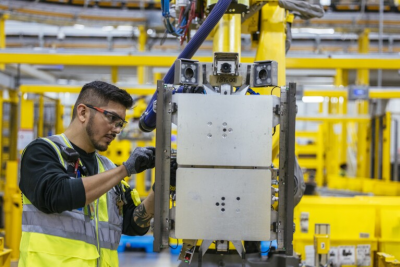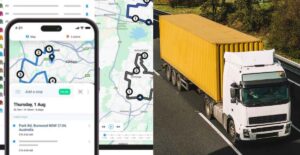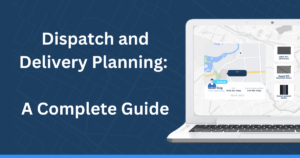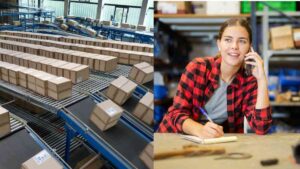Amazon is hard at work to accelerate the use of AI in robotics. The retail giant confirmed it is hiring the three founders of robotics startup Covariant.
Pieter Abbeel, Peter Chen, and Rocky Duan worked at OpenAI before starting Covariant. They will now join Amazon’s fulfillment technologies and robotics team.
Why is this significant? Covariant is at the forefront of AI-powered robotics.
The startup specializes in general-purpose AI to enable robots to learn autonomously. This technology would make Amazon a leader in the field of warehouse automation.
Covariant confirmed that Amazon will receive a non-exclusive license to Covariant’s Robotic Foundation Models.
The Amazon-Covariant partnership
Covariant says the partnership will help the startup to optimize its business so the team can “continue inventing solutions for [their] customers’ most persistent and costly warehouse automation challenges.”
Apart from the three founders – Chen, Abbeel, and Duan – other key members of the research and engineering teams will join Amazon. Meanwhile, chief operating officer Ted Stinson and head of product Tianhao Zhang will take the reins at Covariant.
Meanwhile, Amazon’s VP of fulfillment technologies and robotics, Joseph Quinlivan, says they are excited to work with the Covariant team on “the next generation of robotics that will drive forward the state-of-the-art in automation.”
To fully understand the impact of this move, let’s first look at how Amazon evolved its robotics capabilities over the years.
Amazon’s history with robotics
Amazon has been in the robotics games for quite some time. It started in 2012 with the acquisition of Kiva Systems. This allowed Amazon to automate its logistics and warehouse operations.
With the capability to automate fulfillment centers with mobile robots, Amazon expanded at a massive scale.
Beyond the Kiva acquisition, Amazon also introduced the Sparrow and Proteus robotic arms, as well as new automated sorting systems.
Watch: Amazon’s robotic arms in action
Tye Brady, the chief technologist at Amazon Robotics, says the robotic arms have an array of suction cups to grab objects, and sensors positioned in such a way to look down into warehouse crates and identify the objects in it.
It also has a “perception stack that is then saying, ‘Okay, if that’s what’s inside the tote, this is where I want the arm or the end effector to go in order to pick it up’.”
It also predicts how heavy an object will be, and where it should grab the object by predicting the object’s center of gravity.
This level of innovation has been advanced further by other robotics players. Such as Covariant, a key player in AI-driven robotics. So, who exactly then is Covariant?
The rise of Covariant
The startup was founded in 2017 to advance robotic intelligence. The company’s goal is to develop adaptive general-purpose AI for robots capable of autonomously learning and performing complex tasks.
What sets Covariant apart in this field? Covariant robots improve continuously, thanks to its deep integration of machine learning.
These robots learn from experience – similar to how humans believe ‘practice makes perfect’ – as opposed to relying on traditional programming. In other words, their robots are perfect for logistics and warehousing, where automation is crucial for safety and scaling operations.
Watch: AI-powered robot pick-and-packing
Covariant has partnered with key players across several industries – including logistics, retail, and manufacturing. Notable clients include:
- McKesson, a healthcare company.
- Otto Group, a retail and services group.
- Capacity, a third-party logistics (3PL) firm.
- Radial Inc, an e-commerce solutions provider.
ALSO READ: IKEA’s new wingman – AI drones tackle warehouse chaos
What could Amazon be planning?
Quinlivan gives us some indication of what’s in store: “We will advance fundamental research, marrying our rich expertise to unlock new ways for AI and robots to assist our operations employees.”
By incorporating Covariant’s AI tech into Amazon’s existing robot fleet, they hope to “make [the fleet] more performant and create real-world value for our customers,” Quinlivan adds.
With this tech, Amazon’s robotic fleet could handle increasingly complex logistics tasks. The type of tasks that require adaptability – identifying items, picking up items with irregular shapes, etc.
As the retail giant expands on its robotics capabilities, we can likely expect advancements where robots autonomously navigate more unpredictable and complex environments.
After all, three years ago, Abbeel said things are always changing in the real world. That is why AI research and development is required to meet real-world demands and challenges.
He compared teaching a robot to run on a flat surface with teaching a robot to identify warehouse objects autonomously.
On a flat surface, nothing changes. In a warehouse handling delivery items, it’s always changing. “You’re opening a box. You have to decant it. What’s in there? How is it packed?
“It’s always going to be something new, packed differently. So you need to adapt on the fly, do whatever you are dealt.”
NOW READ: Cobots: The Ultimate Guide to Collaborative Robots
Image credit: Amazon US.
About the author
Cheryl has contributed to various international publications, with a fervor for data and technology. She explores the intersection of emerging tech trends with logistics, focusing on how digital innovations are reshaping industries on a global scale. When she's not dissecting the latest developments in AI-driven innovation and digital solutions, Cheryl can be found gaming, kickboxing, or navigating the novel niches of consumer gadgetry.












